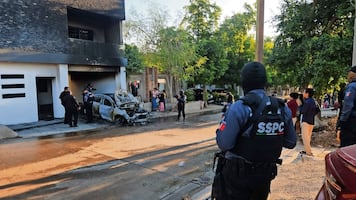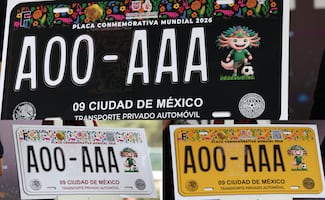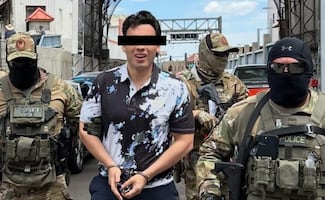At Café Río , people drink time with small sips, with no sugar, along with a date pie, a good conversation, or a book. Sometimes, they only sit at the table with the absence of those who once walked thorough Donceles street and stayed there forever.
“Chinito, can I have a light Americano?” says Gema Serna Hauayek. This story could not begin in any other way. She is the current owner of Café Río, a business that belongs to her family since 1961 when her mother, Lidia Nayer Hauayek was in charge.
“It’s a very popular café ; it is visited by artists, writers, politicians, all kinds of people who like good coffee ,” said Gema with one of her three daily cups in her hands, with no sweetener, as her mother used to have it before she died two years ago.
This place does not only stand out due to its age and for being a family business, as explained by chronicler Jorge Pedro Uribe Llamas, it also represents a kind of commerce that resists in downtown Mexico City .

“Traditional or historical businesses in downtown Mexico City are disappearing at a fast pace thanks to massive tourism, real estate speculation, gentrification, user rights, and other big problems that local authorities have not been able or have not wanted to address,” adds the chronicler.
At Café Río, the mural portraying coffee plantations has already forgotten the signature of its author but still shows the fields. The machine for toasting coffee is still at the entrance and although it is no longer used, it invites passerbies to come in and build new stories at a stage from the past.
Gema says that you could find at the tables of Café Río people like journalist Jacobo Zabludovsky or businessman Carlos Slim, who drank expressos ; writer José Emilio Pacheco asked for an americano: poet Vicente Quirarte drinks a capuccino when he comes visits, just as chronicler Ángeles González Gamio and historian Guillermo Tovar y de Teresa.
Café Río counts Damián Alcázar among its clients who likes “bride fingers” and actor Jesús Ochoa, who is a fan of date pies.

Legendary Mexican diva María Félix also visited the café although she did not drink anything; she only sat at the last table to wait for the antiquities shop upstairs to open.
Ángeles González Gamio mentions in Los encanto de una calle that Café Río was the favorite of lawyers that went to the courts that used to be located at the old convent La Enseñanza.
“San Ildefonso’s high school students were also loyal customers; they were the 60s from the 20th century, a time when students discovered Sartre and young women were fascinated by Simone de Beauvoir’s feminist ideas,” wrote the chronicler.
While drinks got cold, conversations got heated with any topic, such as the films of the Río Movie Theater which, according to González Gamio, were considered pornographic back then but would now be considered mild.

Students also looked for Mrs. Lidia , “she was a very quiet person; if you told her something, she would not tell anybody, so if you had a problem, she would give you good advice… some people called her mother,” remembers Gema.
José Joaquín Blanco describes in Los mexicanos se pintan solos : “in the remains of the university neighborhood (behind the cathedral), small cafés like Café Río, in Donceles, where all poets from San Ildefonso Highschool discuss rhymes and – oh! - life!”

Lebanese-Mexican Tradition
“My grandma was really brave,” says Gema, with her cup of coffee halfways. After losing her mother, when she was 16 years old, she left Zgharta, a citiy in Lebanon, for Venezuela, where her older brother lived.
In the way, the boat in which her grandmother was traveling broke down in Veracruz and she stayed here, as though fate had brought her to Coatepec’s coffee , which is the one served at the family business in Donceles.
“She, without knowing the language, young and scared, looked for her friends in Mexico… a friend rescues her and takes her to Pachuca.” Then, she got married in the pastes state. That is how the story of the Hauayek family began in Mexico .

Sometime later, in Mexico City, her daughter Lidia devoted her life to the café. Back then, downtown Mexico City had a strong presence of people from Lebanon as well as Jewish people and Spaniards, according to journalist Patricia Ruvalcaba.
All of Mrs. Lidia’s daughters learned how to prepare beverages since they were seven years old when they still needed a stool to reach the coffee machine’s levers. After spending 17 years working at a fabrics supplier, Gema quit to completely focus on the family business .

She is from Mexico City but her seasoning keeps Lebanese tradition . Every Wednesday at Café Río, she prepares, with the unique accuracy of her hand, the recipes she inherited from generations. The flavors are so popular that two hours are enough to empty the pots.
Arturo Villegas wrote that this place is “The belly” of downtown Mexico City: “It’s like visiting your aunt’s house after receiving a warm and honest embrace followed by an insult for having abandoned them, Gema and her sister Thelma will invite you to sit down.”
The mirrors on the wall show the memories and Gema's reflection, who almost never sits down.

Cafés, full of possibilities
With each sip of coffee , words improve, hands fly over keyboards, stories take shape, decisions seem clearer, possibilities overflow the cups.
Why does this happen around coffee? Researcher Victoria Aupart says that this beverage is one of the best-accepted drugs; it has stimulating properties: caffeine alters the nerves and causes “an unusual clarity that is not contained by other beverages.”

“A café itself has a very specific characteristic; inviting people to do everything and to do nothing; it is not a space that is specifically defined by the activities performed inside but by the wide range of activities people can do,” explains Aupart.
At Café Río, people have chosen to form a community. There are old customers that greet Gema with love and she knows their order by heart. A group of retired teachers has met twice a week for almost half a century at the café.

Other people, like Jesús Castro, are almost part of the café . While he rests at one of the tables, he tells how he traverses the streets with his broom since he was young; every day, he helped Mrs. Lidia lift the curtain and she told him coffee did not take her sleep away: “No, güero, I wake up at one or two, when I can’t sleep, and I get a cup of coffee and fall asleep.”
From those tables, Don Jesús saw the trolley disappear, the changes in the flow of vehicles, “it was nice before… now, they want malls everywhere,” said the 71-years-old man.
“Many merchants came here; they have left downtown, some have died; life changes; I was young, now I’m not,” said Gema with a laugh. However, new generations have also been seduced by this place.
At 86 Donceles street, the 1960s coffee machine keeps waking up the neighborhood, it remains tireless, serving one cup of coffee after another, with the flavors of ancient Mexico .

mp
Noticias según tus intereses
[Publicidad]
[Publicidad]














